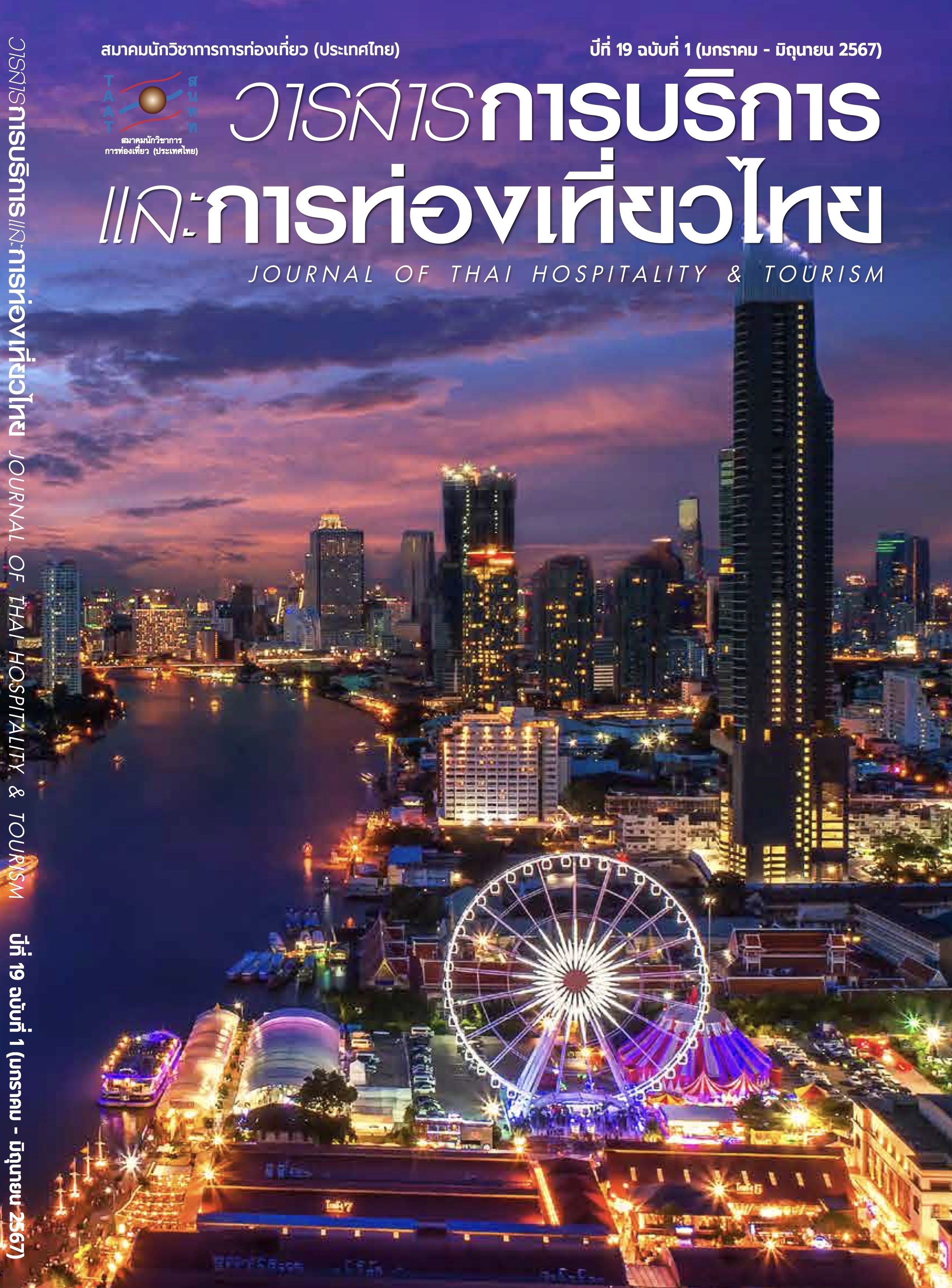The Assessment of Geosites for Geotourism Development in Kanchanaburi Province
Main Article Content
Abstract
In this study, a systematic investigation has been conducted at four geosites in Kanchanaburi Province, Thailand: Dr. Bhol Klibbua’s Mine, Mon Village (Tha Sao Village), Chao Pho Khao Chon Kai Shrine, and Lan Lava (Bo Phoi basalt). The investigation included inventory, characterization, assessment, and evaluation to study the geotourism potential of the sites. Certain criteria used for evaluation have been developed by the Department of Mineral Resources. Qualitative assessment has been carried out on the educational potential and the development and management levels of potential.
The results show that the educational value of Chao Pho Khao Chon Kai Shrine and Lan Lava was high (83% and 77%, respectively), while it was moderate for Dr. Bhol Klibbua’s Mine and Mon Village (62% and 58%, respectively). All four geosites have the potential for development and management at a moderate level (ranging between 50 and 58%). To sustainably develop and encourage these geosites, there should be the dissemination of geological knowledge and an emphasis on the importance of geosites for the communities and relevant organizations to make them more aware of the need to conserve and cherish their lands. The improvement and management of all relevant organizations working as a team can sustain geotourism in the best interests of the sites.
Article Details

This work is licensed under a Creative Commons Attribution-NonCommercial-NoDerivatives 4.0 International License.
References
Barr, S. M. & Macdonald, A. S. (1981). Geochemistry and Geochronology of Late Cenozoic Basalts of Southeast Asia: Summary. Geological Society of America Bulletin, 92(8), 508–512.
Bunopas, S. (1976). Geology Map of Thailand, Scale 1:250,000 Sheet Suphan Buri ND 47–7. Geological Survey Division.
Bunopas, S. (1981). Paleogeographic History of Western Thailand and Adjacent Parts of Southeast Asia: A Plate Tectonic Interpretation. Victoria University of Wellington.
Bureau of Mineral Resources Office Region 3 (Pathum Thani). (2014). Geological Survey and Evaluation of Kanchanaburi Province. Ministry of Natural Resources and Environment.
Department of Mineral Resources (DMR). (2008). Zonation for Geological and Resources Management, Kanchanaburi Province. Ministry of Natural Resources and Environment.
Department of Mineral Resources (DMR). (2013). Valuable Natural Heritage – Geosites of Thailand. Geological Survey Division.
Department of Mineral Resources (DMR). (2014). Guidelines for the Geo-Conservation and Management by Department of Mineral Resources. Ministry of Natural Resources and Environment.
Eventpass. (2021). Dr. Bhol Klibbua’s Tunnel, Kanchanaburi Province. https://www.eventpass.co/event/c8zeZU
Jantakham, S. & Sairaksa, D. (2020). The Geotourism Development Strategies for Khon Kean Geopark Towards to UNESCO Global Geopark. Journal of Education Rajabhat Maha Sarakham University, 17(1), 599-611.
MGR Online. (2017). An Excited Journey! Tunnel Warfare in Thong Pha Phum, Kanchanaburi. https://mgronline.com/travel/detail/9600000087081
National Geopark Committee. (2021a). Guidelines for Geological Evaluation. https://t.ly/N-Q8
National Geopark Committee. (2021b). What is the Geopark? https://t.ly/5sXC
Nazaruddin, D. A. (2019). Selected Geosites for Geoheritage, Geotourism, and Geoconservation in Songkhla Province, Southern Thailand. Quaestiones Geographicae, 38(1), 161-177.
Pispunt, P. & Kunta, K. (2020). Waste Management and Implementation of the Green National Park Project for Waste in Phu Ruea National Park, Loei Province. Journal of Research and Development, Buriram Rajabhat University, 15(2), 113–126.
Pongnirundorn, S., Buatham, O. & Yodsuwan, C. (2016). Guidelines for Effective Development in Tourism Management of Wang Nam Khiao District, Nakhon Ratchasima Province. MBA-KKU Journal, 9(1), 234–259.
Prapoodtaborirak, K. M., Sirisawat, C. & Sairuksa, D. (2018). A Waste Management Model for Phu Phra Bat Historical Park Area, Udon Thani Province. Chophayom Journal, 29(2), 289–299.
Rout, P. & Gupta, S. K. (2017). Asset Based Community Development in Mountain Environs: A Strategic Application for Sustainable Community Based Tourism Development in the Jaunsar–Bawar Region of Uttarakhand, India. African Journal of Hospitality, Tourism and Leisure, 6(3), 1–11.
Saminpanya, S. (2011) Geotourism: Watphraphutthachai, Saraburi. Srinakharinwirot University (Journal of Science and Technology), 3(6), 1-8.
Singtuen, V. & Phajuy, B. (2020) Archaeological Distribution of Geoheritage for Geotourism Development in Nakhon Sawan Province, Thailand. Quaestiones Geographicae, 39(3), 57-68.
Suansri, M. (2016). The Development Guidance and Tourism Promotion Effect to Bangnamphung Floating Market, Samut Prakan Province’s Uniqueness. Journal of Cultural Approach, 17(31), 41–55.
Suensilpong, S., Nakornsri, N., Dheeradilok, P., Lumjuan, A., Tansathien, W. & Vimuktanadana, S. (1982). Geological Map of Thailand: Geological Survey Division, Department of Mineral Resources, Thailand, Scale 1:1,000,000, 2 Sheets. Geological Survey Division.
Sutthirat, C., Charusiri, P., Farrar, E. & Clark, A. H. (1994). New 40Ar/39Ar Geochronology and Characteristics of Some Cenozoic Basalts in Thailand. Paper Presented at the International Symposium on Stratigraphic Correlation of Southeast Asia, Bangkok.
Tepsongkroh, P. (2016). A Study of Fossil Evidences on Karst Topography for Promotion of Geotourism in Satun Province. Journal of Humanities and Social Sciences, Thaksin University. 11(special), 135-176.
Thaweeburut, S. (2018). Potential of Geotourism Resources for Environmental Friendly in Geopark, Satun Province. Prince of Songkla University.
UNESCO Bangkok Office. (2018) Satun Becomes Thailand’s first UNESCO Global Geopark. https://bangkok.unesco.org/content/satun-becomes-thailand%E2%80%99s-first-unesco-global-geopark
United Nations Educational, Scientific and Cultural Organization (UNWTO). (2022). UNESCO Global Geoparks Council Proposes 7 New Geoparks for Endorsement. https://www.unesco.org/en/articles/unesco-global-geoparks-council-proposes-7-new-geoparks-endorsement
Wechtunyagul, P. (2020). Ecotourism to Sustainable Tourism. Journal of Sustainable Tourism Development, 2(1), 50–63.
Yaowanoiyothin, W. & Kuttikul, P. (2013). Handbook of Satun’s Fossil Land. Geological Survey Division.


